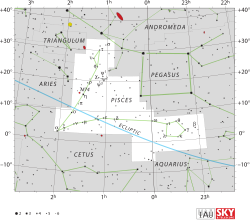Omega Piscium
| Observation data Epoch J2000.0 Equinox J2000.0 (ICRS) | |
|---|---|
| Constellation | Pisces |
| Right ascension | 23h 59m 18.69064s[1] |
| Declination | +06° 51′ 47.9562″[1] |
| Apparent magnitude (V) | 4.01[2] |
| Characteristics | |
| Spectral type | F4 IV[3] or F4 V[4] |
| U−B color index | +0.07[2] |
| B−V color index | +0.42[2] |
| Astrometry | |
| Radial velocity (Rv) | +2.9±0.3[5] km/s |
| Proper motion (μ) | RA: +150.35[1] mas/yr Dec.: −112.12[1] mas/yr |
| Parallax (π) | 31.26 ± 0.15 mas[1] |
| Distance | 104.3 ± 0.5 ly (32.0 ± 0.2 pc) |
| Absolute magnitude (MV) | +1.51[6] |
| Details | |
| ω Psc A | |
| Mass | 1.22[7] M☉ |
| Luminosity | 21[6] L☉ |
| Surface gravity (log g) | 3.74±0.14[7] cgs |
| Temperature | 6,641±226[7] K |
| Metallicity [Fe/H] | −0.09[8] dex |
| Rotational velocity (v sin i) | 40.3[9] km/s |
| Age | 1.337[7] Gyr |
| Other designations | |
| Database references | |
| SIMBAD | data |
Omega Piscium (Omega Psc, ω Piscium, ω Psc) is a star approximately 106 light years away from Earth, in the constellation Pisces. It has a spectral type of F4IV, meaning it is a subgiant/dwarf star, and it has a temperature of 6,600 kelvins. It may or may not be a close binary star system. Variations in its spectrum were once interpreted as giving it an orbital period of 2.16 days, but this claim was later debunked as false. It is 20 times brighter than the Sun and is 1.8 times greater in mass, if it is a single star.[11]
Counting stars with Flamsteed numbers, Greek letters, and proper names, Omega Piscium was the named star with the highest right ascension (akin to terrestrial longitude). Due to the 26,000-year wobble of the Earth's axis, this changed in 2013, when its right ascension was reset to 0 hours. It is the first star to the east of the Circlet of Pisces,[11] which represents the head of the western fish in the constellation.[12]
Naming
- In the catalogue of stars in the Calendarium of Al Achsasi al Mouakket, this star was designated Dzaneb al Samkat, which was translated into Latin as Cauda Piscis, meaning the tail of fish.[13]
- In Chinese, 霹靂 (Pī Lì), meaning Thunderbolt, refers to an asterism consisting of refers to an asterism consisting of ω Piscium, β Piscium, γ Piscium, θ Piscium and ι Piscium. Consequently, the Chinese name for ω Piscium itself is 霹靂五 (Pī Lì wu, Template:Lang-en.)[14]
References
- ^ a b c d e van Leeuwen, F. (2007), "Validation of the new Hipparcos reduction", Astronomy and Astrophysics, 474 (2): 653–664, arXiv:0708.1752, Bibcode:2007A&A...474..653V, doi:10.1051/0004-6361:20078357.
- ^ a b c Johnson, H. L.; et al. (1966), "UBVRIJKL photometry of the bright stars", Communications of the Lunar and Planetary Laboratory, 4 (99), Bibcode:1966CoLPL...4...99J.
- ^ Griffin, R. F.; Redman, R. O. (1960), "Photoelectric measurements of the λ4200 A CN band and the G band in G8-K5 spectra", Monthly Notices of the Royal Astronomical Society, 120: 287, Bibcode:1960MNRAS.120..287G, doi:10.1093/mnras/120.4.287.
{{citation}}: CS1 maint: unflagged free DOI (link) - ^ Abt, Helmut A. (2009), "MK Classifications of Spectroscopic Binaries", The Astrophysical Journal Supplement, 180 (1): 117–18, Bibcode:2009ApJS..180..117A, doi:10.1088/0067-0049/180/1/117.
- ^ Gontcharov, G. A. (November 2006), "Pulkovo Compilation of Radial Velocities for 35495 Hipparcos stars in a common system", Astronomy Letters, 32 (11): 759–771, arXiv:1606.08053, Bibcode:2006AstL...32..759G, doi:10.1134/S1063773706110065.
- ^ a b Anderson, E.; Francis, Ch. (2012), "XHIP: An extended hipparcos compilation", Astronomy Letters, 38 (5): 331, arXiv:1108.4971, Bibcode:2012AstL...38..331A, doi:10.1134/S1063773712050015.
- ^ a b c d David, Trevor J.; Hillenbrand, Lynne A. (2015), "The Ages of Early-Type Stars: Strömgren Photometric Methods Calibrated, Validated, Tested, and Applied to Hosts and Prospective Hosts of Directly Imaged Exoplanets", The Astrophysical Journal, 804 (2): 146, arXiv:1501.03154, Bibcode:2015ApJ...804..146D, doi:10.1088/0004-637X/804/2/146.
- ^ Pace, G. (March 2013), "Chromospheric activity as age indicator. An L-shaped chromospheric-activity versus age diagram", Astronomy & Astrophysics, 551: 4, arXiv:1301.5651, Bibcode:2013A&A...551L...8P, doi:10.1051/0004-6361/201220364, L8.
- ^ Schröder, C.; Reiners, A.; Schmitt, J. H. M. M. (January 2009), "Ca II HK emission in rapidly rotating stars. Evidence for an onset of the solar-type dynamo" (PDF), Astronomy and Astrophysics, 493 (3): 1099–1107, Bibcode:2009A&A...493.1099S, doi:10.1051/0004-6361:200810377.
- ^ "ome Psc". SIMBAD. Centre de données astronomiques de Strasbourg. Retrieved 2017-07-22.
{{cite web}}: CS1 maint: postscript (link) - ^ a b "Omega Psc". Archived from the original on April 30, 2007. Retrieved September 30, 2007.
{{cite web}}: Unknown parameter|deadurl=ignored (|url-status=suggested) (help) - ^ "Western Pisces". Archived from the original on June 15, 2007. Retrieved September 30, 2007.
{{cite web}}: Unknown parameter|deadurl=ignored (|url-status=suggested) (help) - ^ Knobel, E. B. (June 1895). "Al Achsasi Al Mouakket, on a catalogue of stars in the Calendarium of Mohammad Al Achsasi Al Mouakket". Monthly Notices of the Royal Astronomical Society. 55: 430. Bibcode:1895MNRAS..55..429K. doi:10.1093/mnras/55.8.429.
{{cite journal}}: CS1 maint: unflagged free DOI (link) - ^ Template:Zh icon AEEA (Activities of Exhibition and Education in Astronomy) 天文教育資訊網 2006 年 7 月 8 日

